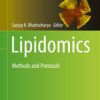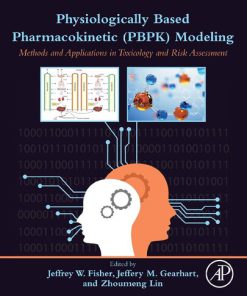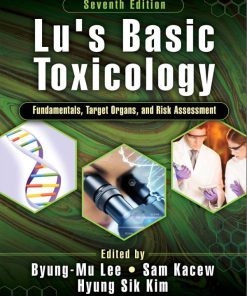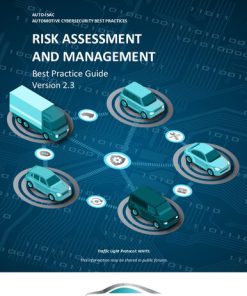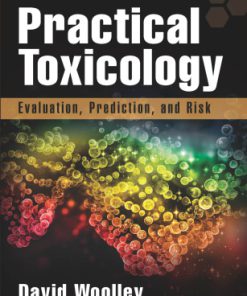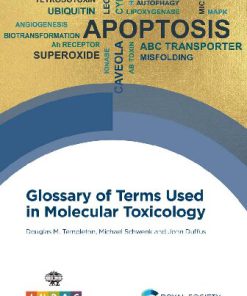Molecular Biological Markers for Toxicology and Risk Assessment 1st Edition Bruce 0128019018 9780128019016
$50.00 Original price was: $50.00.$25.00Current price is: $25.00.
This completed downloadable of Molecular Biological Markers for Toxicology and Risk Assessment 1st Edition Bruce A. Fowler

Instant downloaded Molecular Biological Markers for Toxicology and Risk Assessment 1st Edition Bruce A. Fowler pdf docx epub after payment.
Product details:
- ISBN 10: 0128019018
- ISBN 13: 9780128019016
- Author: Bruce A. Fowler
Molecular Biological Markers for Toxicology and Risk Assessment provides an introduction to the exciting field of biomarkers and their use in toxicology and risk assessment. In recent years, new classes of molecular biomarkers capable of detecting early manifestations of ongoing chemical-induced cell injury and cell death have been developed as a result of advances in analytical chemistry, molecular biology, and computational modeling. The interplay between these emergent tools of science has resulted in new insights into initial mechanisms of chemical-induced toxicity and carcinogenicity.
Table of contents:
Chapter 1: Molecular Biological Markers for Toxicology and Risk Assessment
Abstract
1. Introduction
2. Enzyme Activity–Based Biomarkers
3. Currently Measured Biomarker Proteins
4. Omic Biomarkers
5. Computational Toxicology Approaches
6. Application of Molecular Biomarkers for Risk Assessment
Chapter 2: Historical Development of Biomarkers
Abstract
1. Biomarkers of Exposure
2. Exposome and Biomarkers of Exposure
3. Specific Biomonitoring Analytical Methodologies
4. Biomonitoring Studies
5. Biological Monitoring for Chemical Metabolites and Interconverted Chemical Species
6. Clinical Biomarkers—Current Usages and Prospects for the Future
7. Biomarker Modifying Factors and Identification of Populations at Risk
8. Technical Advances in Instrumentation
9. Basic Scientific Biomarker Validation Approaches
Chapter 3: Computational Toxicology
Abstract
1. Introduction
2. Data Mining Approaches—Getting an Overview of the Current Molecular Biomarker Literature
3. Some Useful and Publically Available Data Resources
4. International Public Health Databases
5. European Union
6. Chemical Risk Assessment Resources in Selected Countries and States
7. WHO Chemical Risk Assessment Network
8. Computational Toxicology Approaches to Biomarker Development and Validation
9. Toxicology Testing Resources in Europe
10. Computational Tools for Capturing the Biomarker Literature
11. Computational Approaches for Assisting in Molecular Biomarker Development
12. Applications of Computational Methods for Guiding Biological Marker Research—A Summary
Chapter 4: Omic Biological Markers
Abstract
1. Introduction
2. Statistical/Bayesian Approaches for Delineating Biomarkers
3. Proteomics
4. Metabolomics/Metabonomics
5. Current Applications of Omic Biomarkers for Risk Assessment Purposes
Chapter 5: Validation of Biological Markers for Epidemiological Studies
Abstract
1. Introduction
2. Molecular Biomarker Validation Through Correlation With Other Biological Endpoints
3. Application of Computational Modeling Approaches for Extrapolating From In Vitro or Experimental Animal Model Systems for Molecular Biomarker Validations
4. Ease of Application for Risk Assessment Practice
5. Correlations at the Population Level and Population-Based Risk Assessment Studies via NHANES
6. Applications to Risk Assessment Practice
Chapter 6: Technical Translational Analysis of Molecular Biomarker Data
Abstract
1. Introduction
2. Modeling and Interpretation of Data
3. Integration of Diverse Data Sets
4. Validation of Biological Marker Data With Other Outcome Data
Chapter 7: Quality Assurance/Quality Control (QA/QC) for Biomarker Data Sets
Abstract
1. Introduction
2. General Definitions
3. Discussion of QA/QC Definition
4. Sample Handling for Biomarker Development
5. Intrinsic Variability of Measured Biomarker Endpoints
6. Equipment Maintenance, Internal Standards, and Chain of Custody for Assurance of Data Quality
7. Data Analysis and Archival Storage Needs
8. Summary and Conclusions
Chapter 8: Translation of Biomarkers for Human Clinical and Epidemiological Studies
Abstract
1. Introduction
2. Clear Definitions of Biomarker Terminology
3. Biomarkers for Epidemiological Studies
4. Biomarkers for Chemical Mixture Risk Assessments
5. Merging Chemical Exposure Data and Genetic Inheritance Data for Risk Assessments
6. Summary and Conclusions
Chapter 9: Risk Communication of Molecular Biomarker Information
Abstract
1. Introduction
2. Information Mapping Technology
3. Translation of Molecular Biomarker Data for Societal Decision Making
4. Summary and Conclusions
Chapter 10: Future Research Directions
Abstract
1. Further Validation of Biological Markers for Humans and Barriers to Acceptance Into Risk Acceptance Practice
2. Application of Artificial Intelligence Computer Programs for Integrating Diverse Data Sets and Facilitating Risk Assessments
3. Calculation of Acceptable Exposure Levels for Chemicals on an Individual or Mixture Basis
4. Incorporation of Individual Genotypes Into Biological Marker-Based Risk Assessments
5. Getting on the Rising Road—Some Suggestions
People also search:
molecular biomarker
molecular marker testing
biological markers examples
molecular biology forensic science
biological markers definition
You may also like…
Medicine - Pharmacology
History & Research
A Clinician s Guide to Suicide Risk Assessment and Management 1st Edition Joseph Sadek
Medicine
Lu’s Basic Toxicology: Fundamentals, Target Organs, and Risk Assessment, Seventh Edition Kacew
Business & Economics - Management & Leadership
Strategic Security Management: A Risk Assessment Guide for Decision Makers 2nd Edition Karim Vellani
Computers - Security
Science (General)


